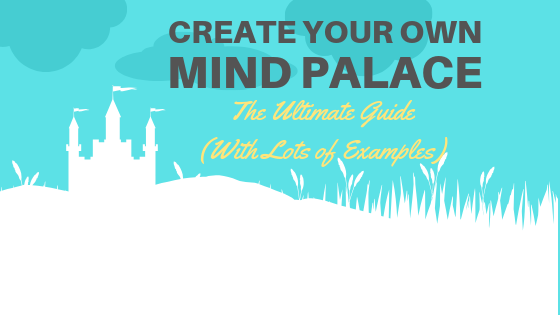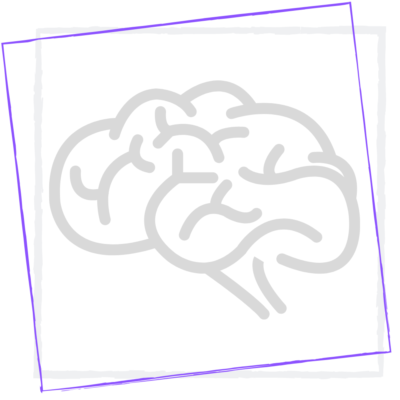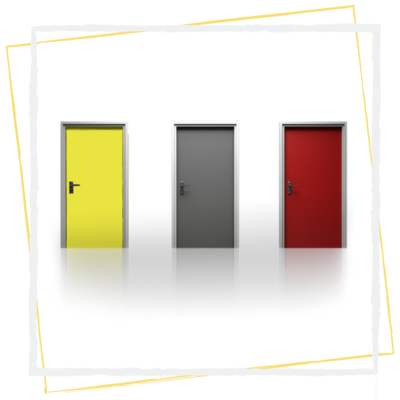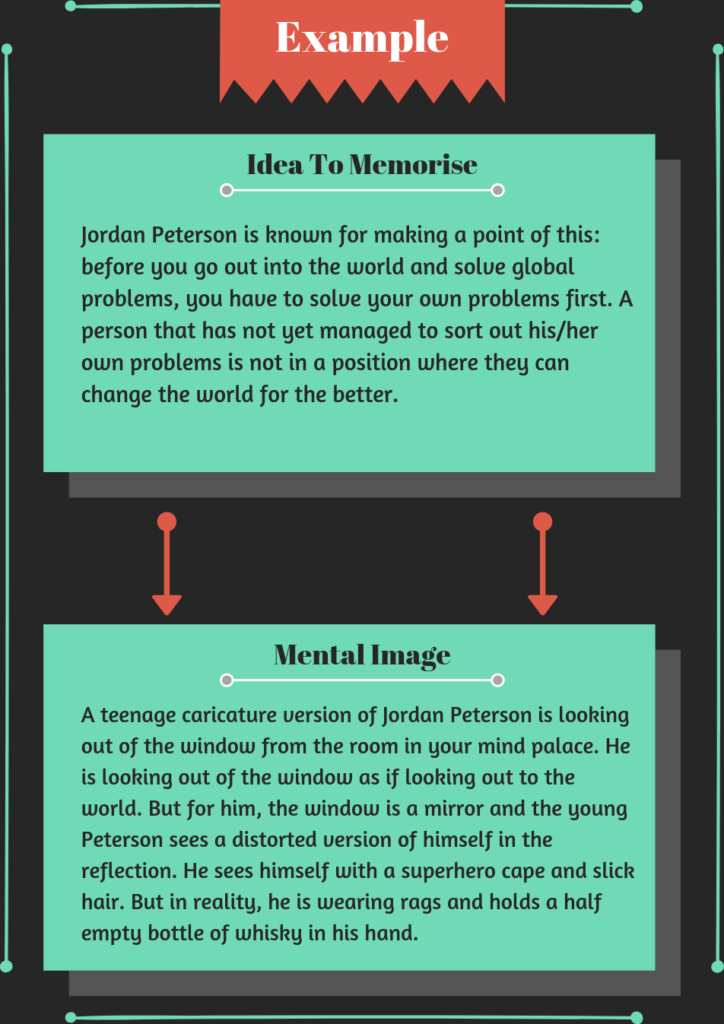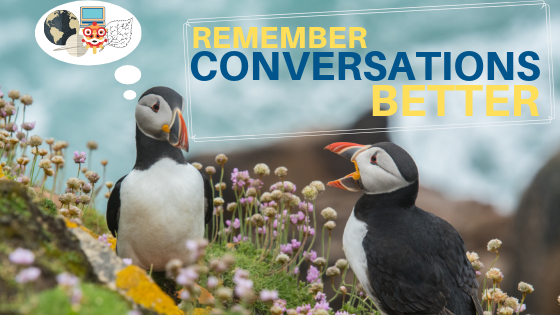
- Home
- •
- Blog
- •
- Memorisation
- •
- How to Build Your...
Chapter 1
WHAT YOU WILL LEARN
![]()
Let's first briefly go through what you will learn from this article.

If you search online about how to learn this technique, you will find a lot of guides teaching you the traditional type of mind palace. This consists of memorising lists of items in a particular order, and usually facts such as phone numbers, to-do lists and information you will only need temporary.
This is not the type of mind palace I will be teaching you how to make here. I am a lot more interested in techniques that place information in your long term memory rather than your short term memory. This includes subjects you want to learn, concepts you want to remember, important passages from books, or anything else that you want to remember.
I want you to be able to use this technique properly. That's why I'm taking the time to write a complete guide with some length instead of just giving you a few quick tips. I am more interested in giving you a detailed article that will actually help you instead of bite-sized information that only scratches the surface of this subject. A short article wouldn't have done justice to such a wonderful and useful technique. This could be an article that you will come back to now and then if you need a reminder about some of the mind palace concepts.
If you implement this technique and follow my advice, you will own a powerful tool to memorise everything both short term and long term for many years.
Chapter 2
WHAT IS A MIND PALACE?

Before we go through in-depth how to make a mind palace, it is worth first explaining the concept of a mind palace.
In this really short chapter, you will get a good idea of what a mind palace is and how it works.
A mind palace that is used right can be the ultimate memorisation tool that enables you to easily memorise complicated stuff. This has in particular been popularised by the TV series 'Sherlock Holmes.' A mind palace (also called memory palace or memory journey) stems from the method of Loci. Tony Buzan talks about it in his book Use Your Memory. It is a memorisation technique that uses visualisation to enhance your memory of a chosen subject.
A Quick Explanation of How a Mind Palace Works
First, you choose a location that you know well (your friend's house, your old school building etc). Then you make images of the ideas you want to remember and connect them with items in this building, such as a piece of furniture. These ideas can be retrieved from your memory by a mental walk through the mind palace. When you walk through your mind palace, you will see the images you have placed there. From these images, you will recall the information they are connected to.
A mind palace can be used to remember absolutely anything. No restrictions whatsoever. The only restrictions are the restrictions set by your own imagination.
Chapter 3
HOW YOUR BRAIN RETAINS INFORMATION

In order to build the best mind palace possible, you need to consider a few things about how your brain retains information.
What you are about to learn in this chapter is crucial for all kinds of memorisation techniques.

Let's listen to some trusted, established memory experts for this, like Jim Kwik. Jim Kwik is one of the most predominant authorities on the art of memorisation. He is a memory coach that has helped numerous artists, entrepreneurs, CEOs and other people to improve their memory.
One of the most useful things I have learnt from Jim Kwik is his famous statement:
"Information + emotion = long-term memory."
In other words, your emotions affect your memory.
He also says that
"All learning is state dependent."
The reason why a lot of people don't remember much from what they learnt at school is because they were mostly in a bored state while learning. You learn very little when you're bored. In order to maximise your learning speed and your long term memory of what you're learning, you have to find ways of making the material you are trying to learn fun or interesting. What has this got to do with mind palaces?
Lively and colourful mental images are the main ingredients for your mind palace. You want to create images that fuel your emotions positively. Create images that make you happy, make you laugh or that cause other positive reactions in you. Create images that have a genuine impact on your emotions.
Be honest with yourself when you're doing this. If there is something that makes you excited that you are afraid of putting in your mind palace because you're ashamed of it, place it in your mind palace anyway. Get over the fact that it's embarrassing or not morally right. You are the only person who is going to witness your mind palace, so it's fine to keep secrets in there.
Anything sexual should DEFINITELY go in your mind palace. Humans are sexually driven creatures, so sexual images that you combine with objects in your mind palace can be very strong and memorable.
You Memorise When You're Focused
Your brain has to be active when you're learning or when you’re trying to store something in your memory. If you are tired, or in a passive state, it is unlikely that what you're learning will stick to your brain. Of course, there are certain things you can practise that don't require your full attention, but this is a different type of learning and only works on specific motor tasks that you want to consolidate into muscle memory. Technical exercises on musical instruments are good examples of this. For all other things you want to learn, your brain has to be alert, not passive or lazy.
Do something actively in order to store it in your memory. This is an extremely important concept in memorisation.
Create Ridiculous And Absurd Images
Tony Buzan, an expert on learning and memory wrote in his book Use Your Memory that
"The more ridiculous, zany and absurd your mental images are, the more they will be outstanding and thus the more they will be remembered."
He also mentioned that your mental images can be improved by making objects within your image extremely large or extremely tiny. Making these type of mental images is also great practise for your creativity! I will talk more about Tony Buzan later in this guide.
So when you are building images for your mind palace, remember to take all these points into consideration:
- Create images that have an impact on your emotions
- Be focused while you are creating images
- Create ridiculous and absurd images
I'm so ready for this now. Let's start!
Chapter 4
CHOOSE YOUR LOCATION
![]()
Now we have covered some important theory and are finally going to start building your mind palace.
This is where the fun starts.

To create a mind palace, you need a visual representation of a location that you know well. Within this location you are going to create images that you will connect to rooms, furniture and other items that already exist at the location. Your visual representation of this location has to be as strong and easy to remember as a place you have visited physically, in real life. Your mind palace can be a physical place that you have visited before or seen before, but it can also be an imaginary place. The only requirement is that you are able to produce a good mental image of the location with ease.
I will discourage you from choosing your home or a location that you are visiting on a regular basis, at least if there is a chance that the furniture in that building will change or that a refurbishment will take place.
Let's say that you connect a permanent image on a piece of furniture in your mind palace. Later, you go visit the location in real life and notice that the building has been refurbished and all the furniture has been replaced. This might confuse the two different memories you have of that place. To avoid this problem, it is best that you find a stable location that is not likely to change anytime soon.
Choose a Location That Excites You
Now, we are going to implement Jim Kwik's advice:
“Information + emotion = long-term memory.”
The trick is to use a location that is fun to use. This will increase the chances that using your mind palace will be a fun activity for you instead of a boring struggle. If it becomes laborious, you don't take advantage of Kwik's advice, and the technique will be less effective.
I am a massive Harry Potter fan, so the perfect location for me is Hogwarts.

Hogwarts
If you're a Harry Potter fan as well, and the idea of having something important to do with Hogwarts excites you, I recommend that you use this location as well. I can't imagine that Hogwarts would not be a good location for a lot of people's mind palaces. There are so many Harry Potter fans out there. You can also be even more creative with your choice and choose somewhere in Diagon Alley.

Or even Ron's house, the Burrow.
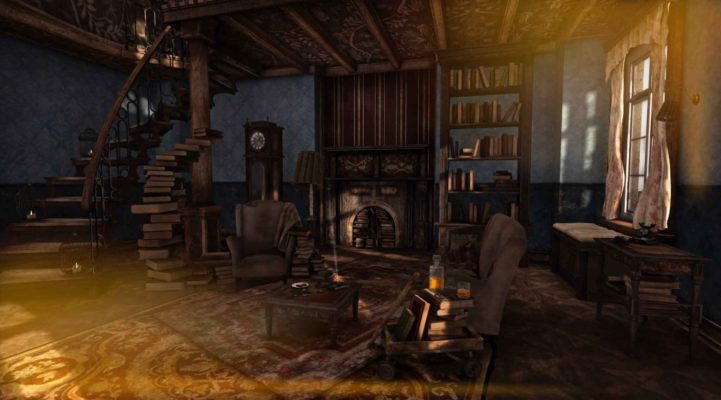
If you want a visual representation to help you memorise what Hogwarts looks like inside, there are a lot of videos on youtube that can be helpful. For example:
https://www.youtube.com/watch?v=kjwGpOjbvf8
This is a video of someone playing a Harry Potter video game. The creators of this video game made such a fantastic and detailed visual representation of Hogwarts that it works perfectly for our purpose. Since it is a bit long and includes a lot of game play, here is a shorter alternative that might work better:
https://www.youtube.com/watch?v=NnCjNxxlWwE&t=840s
The location of your mind palace doesn't even have to be a building. It can be anywhere. It can be an outdoor area with enough landscape varieties so that it can easily be divided into different sections. The advantage of choosing a building, like a house, castle or an apartment is that it's very clear how the building is divided into different sections. It is also easier to make a building unique since it can be furnished in a range of different ways. This is what makes buildings into perfect candidates for mind palace locations. They are user-friendly. The whole point with building a mind palace is that it's easy to remember and to visualise.
Don't choose a difficult location as an attempt to prove to yourself that you have amazing visualisation capabilities. That's not the point.
Don't Be Too Ambitious
Make new rooms and build on your mind palace as you get more mental images to fill it with. Don't try to memorise too much at once. I know it sounds like I'm being ambitious when I choose an enormous castle like Hogwarts for my location. But I started out with a very limited area of Hogwarts - just the courtyard and the Great Hall.
If you memorise too many rooms at once, they will stay empty for ages before you fill them with images. The empty rooms will mean nothing to you, and then you might forget all about them. it's much better to start out with two or three rooms.
The most important condition for me of having chosen Hogwarts as the location for my mind palace is that it excites me that I will have something to do with this place. It's exciting to know that Hogwarts and the Harry Potter universe will be an important and useful part of my life. As a result, building my mind palace is a really fun activity to do instead of a laborious struggle.
This is the feeling I want you to get as well from your choice of location for your mind palace. Choose a location that fires you up!
Chapter 5
SPLIT YOUR MIND PALACE INTO CATEGORIES

Now that you've got a location for your mind palace, let's divide it into categories or rooms.
I imagine that you've got things from several topics that you want to memorise. If you're a student learning about different subjects (physics, philosophy, chemistry etc), start with dedicating one room for each subject. In the future, you might want to expand so that you have one section of the palace for each subject.
If you're not a student but have a lot that you want to learn or memorise, you can still use the same principle.
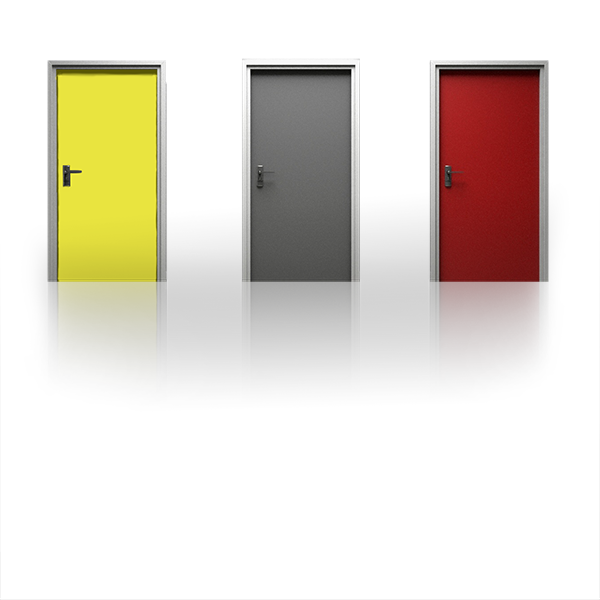
As an example, let’s say you want to memorise things from these subjects:
- Physics
- Psychology
- Passages from books that you read
Let each of these subjects be a room in your mind palace, like this:
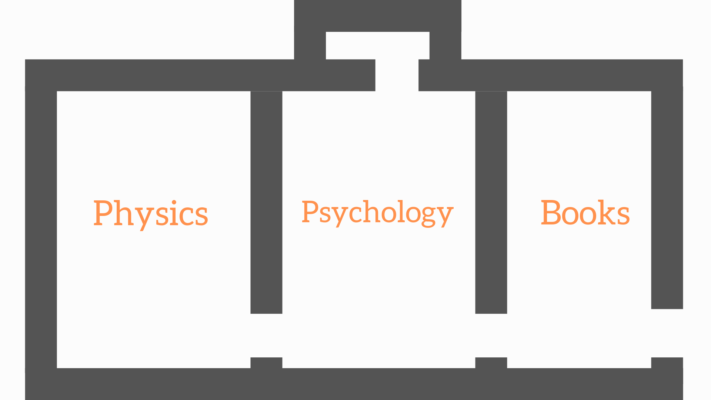
Now we are going to use your ‘book room’ as an example of how to split a room into smaller sections. While doing this, I will also show you what kind of images you can create for the information you want to memorise.
You can have one section of this room for each book. For the sake of this exercise, we are going to say that you want to memorise passages from these two books:
- Sapiens by Yuval Noah Harari
- 12 Rules for Life by Jordan Peterson
(By the way, these are both books that I would warmly recommend to... well, anyone. They both offer great insights into life and the world.)
I'm going to give you one example from each book. First, I will explain the idea or passage from the book to memorise. Then I will go through a suggestion of what image you can make and how to connect it to your mind palace.
Book: Homo Sapiens
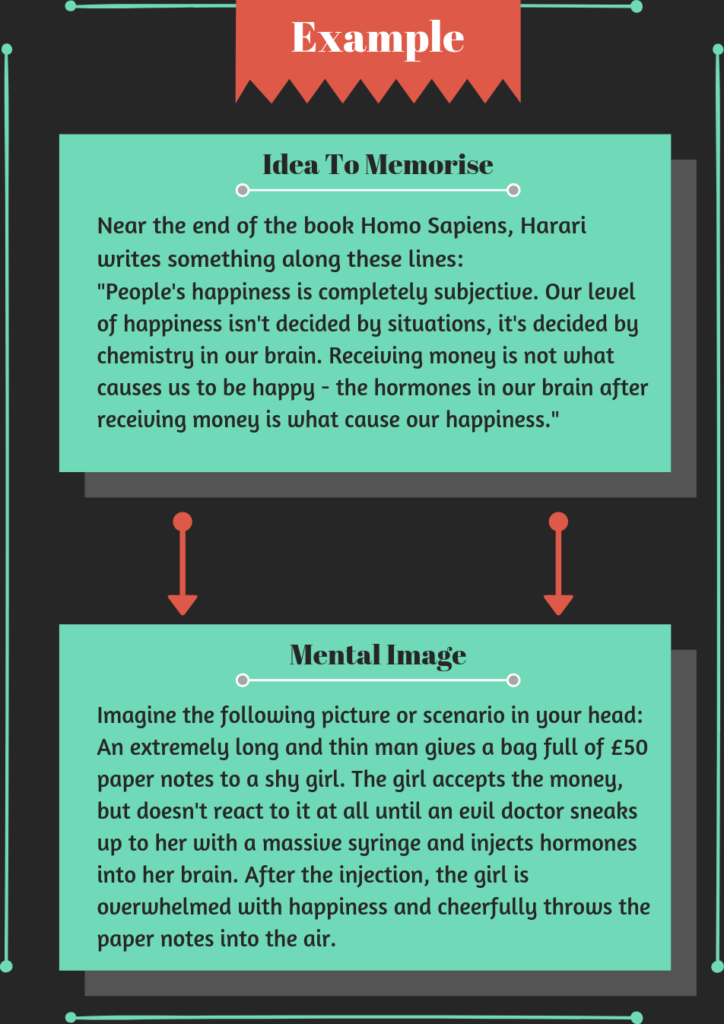
For a lot of people, this could be an idea worth memorising because it says something important about the correct use of terms and the consequences it can have if we use the wrong terms. It applies to a lot of situations in life.
Place this mental image in a specific area of the room and connect it to that area. For example, if there is a rug in the middle of the floor and you place the image on the rug, don't move it from there. Commit this image to that part of the room. The reason why you easily will be able to recall this image sometime in the future is because you remember where in the room you have placed it. An image attached to a specific area in your mind palace is a lot stronger than just the image alone.
There is a reason why I am using very specific images. The images have to be specific so that you remember every detail of them. And the more wacky, weird and extreme your image is, the better you will remember it.
Also, remember to personalise the images. They are for you, and you alone, so you have to make choices that apply to you. For example, the item the thin man gives to the woman could be something that you wish you had. A bag full of money is something a lot of people wish they had. But is there something you wish you had that you didn't want to tell anyone else? Something naughty that you'd rather keep to yourself? Let the thin man give that item instead, whatever it is.
Book: 12 Rules for Life
This image might not make sense to everyone, but that's not the point. These examples I'm giving you are images that would work for me. They don't need to make objective sense. As long as the person who made them understands them, it’s perfect.
Some Tips and Tricks:
- Be creative. If there are topics in your ‘book room’ that relate to something in a room you have dedicated to memorise important quotes, make a portal that goes between these two rooms to connects these two pieces of information.
- There are people that have several mind palaces instead of just one. So if you are afraid that your mind palace might be too small, don’t worry. It’s possible to have several mind palaces for different things.
- If you make images in order to memorise a lot of different points from the same book, find a way to keep these images around the same area of your room. This will help you remember that the ideas came from the same book.
- You might find it easier to dedicate one whole room for each book.
Top Tip:
Imagine that you find yourself in a long conversation with a very inspiring person. There are so many things you want to remember from that conversation. But since you don't have your phone or pen and paper with you, you can't write anything down.
Instead, you force yourself to remember it by repeating it in your head over and over again while you’re still in the conversation. You end up not focusing on the rest of the conversation because you spend all your energy trying to remember what they said in the beginning.
This tip that I will explain now will put an end to this problem.
Dedicate a room in your mind palace that is always empty by default. This will be your short-term memory room. In this room, you will make temporary situations or images for each concept that you want to remember from the conversation you're having (or lecture or something else).
As soon as you hear or see something you want to remember, make a very quick image of it and connect it to your short-term memory room. This process shouldn’t take more than 10 seconds.
Once you have made a strong, bizarre and colourful image, you can ‘forget’ about it for a while because it will stay in your memory for long enough until you have time to write it down.
I use the room of requirements from Harry Potter as my short-term memory room, and it works brilliantly. This is a great way of temporarily remember things before you get a chance to write them down. I have made a whole article about this: Remember Conversations Better
Chapter 6
DECK THE HALLS!

The next thing to do is to fill up those rooms with everything you want to store in your memory.
I have already given you two examples of this. But in this section, I will give you even more examples.

There are some guidelines I recommend that you follow. As I have said before, create images and imaginary scenarios that are easily memorable by you, and no one else. You are creating the mind palace for you, so it's a good idea to be as personal as possible. Use in-jokes that you only have with yourself. In his book Use Your Memory, Tony Buzan suggests creating images using the following components:
- Absurdity - the more wacky, bizarre and extreme your images are, the more they will stand out. For example, if you are going to memorise something where someone eating a burger plays an important part, it's better if the burger is so huge that the person is struggling to eat it.
- Colour - bright colours will make your images more memorable
- Movement - create images that move rather than just still images.
- Senses - using sounds, taste and smell will enhance your memory of the images.
- Sex - this is one of our strongest drives. We can use this to our advantage.
A strong mind palace is a combination of all of these elements.
There are so many different creative ways of building your mind palace, so I choose to give you a few examples of how you can do it so that you get a strong idea of this.
Example 1
Memorising: The concept of "The Problem of Evil" in philosophy
Philosophy is a subject I am really interested in. I have chosen the Great Hall at Hogwarts to be my philosophy room. I am furnishing this room with a lot of philosophical concepts. One of them is the concept of "The Problem of Evil".
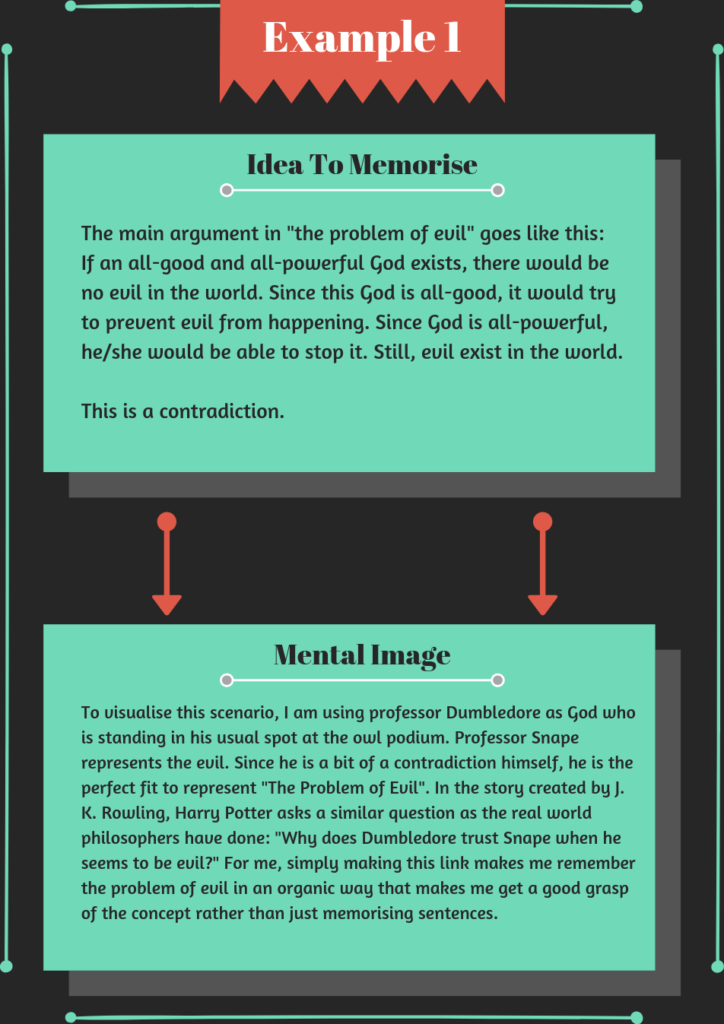
Sentences don't mean anything until you start thinking about them and forming pictures in your head. The images in your mind palace make you do this in a direct manner. If you think about it - When you read something or hear someone say something, you absorb it first as text, then you form an image of it before you finally get an understanding of it. Even though this happens really quickly in your brain we don't really need the first element (text) in every situation.
Instead of this:
TEXT ---> IMAGE ---> UNDERSTANDING
you get this:
IMAGE ---> UNDERSTANDING
Quicker, and more concise.
Example 2
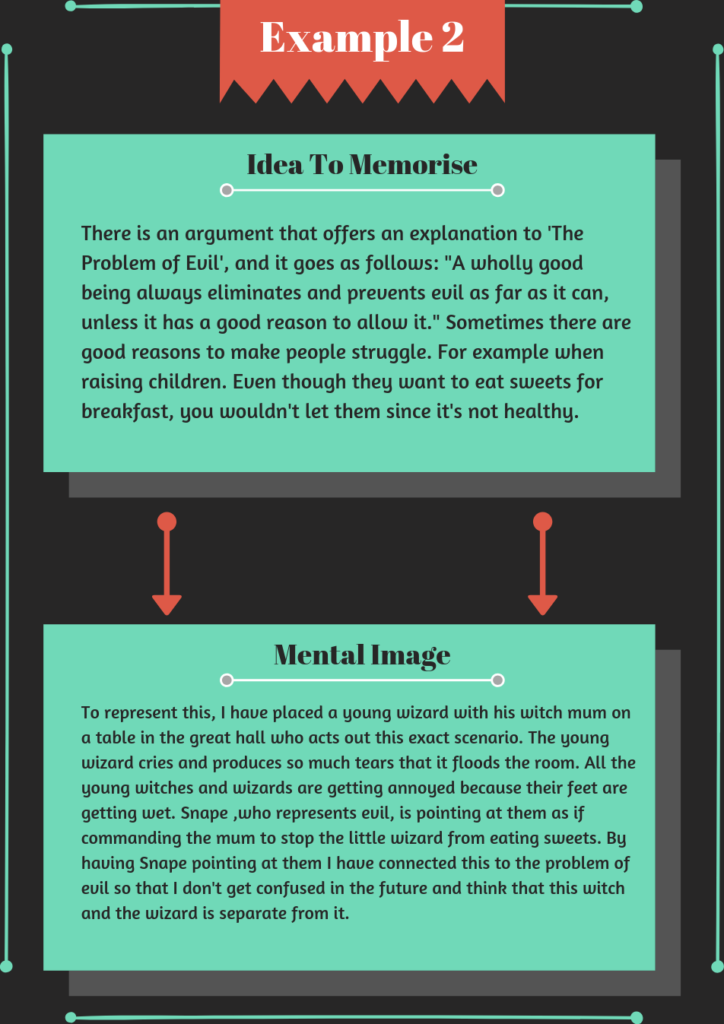
Sources: http://www.wi-phi.com/video/problem-evil]
Since I think this is a compelling argument, I want to be able to recall it on command so that I can communicate it to people without hesitating whenever I need to.
I know that this isn't a particularly difficult concept to remember, but by placing it in my mind palace I am able to remember that it exists and I can draw from this knowledge more directly than having to look it up in my notebook. This is a very powerful thing about using a mind palace.
Now you might see why I think a mind palace is a great tool for people who are involved in debates and have to come up with good arguments on the spot.
Example 3
Memorising: What are the key ideas of the term 'Fascism'?
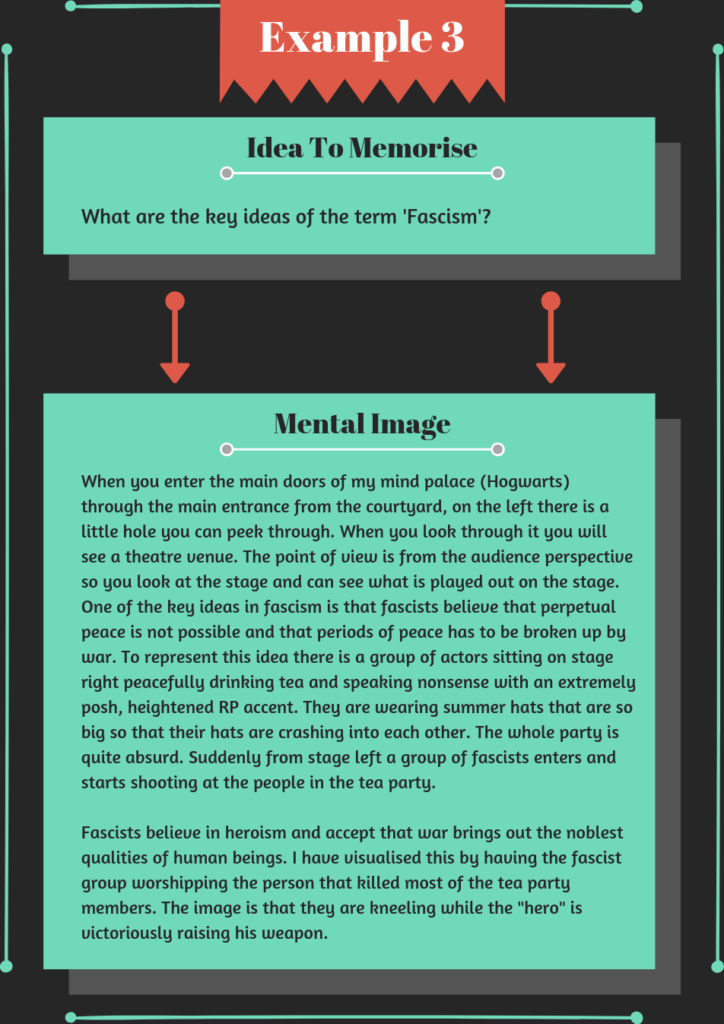
Example 4
Memorising: What does the word 'saccharine' mean?
This is an example of how you can visualise a simpler thing, like a small detail.
If you want to better your vocabulary, you can have a room dedicated to memorising the meaning of words.
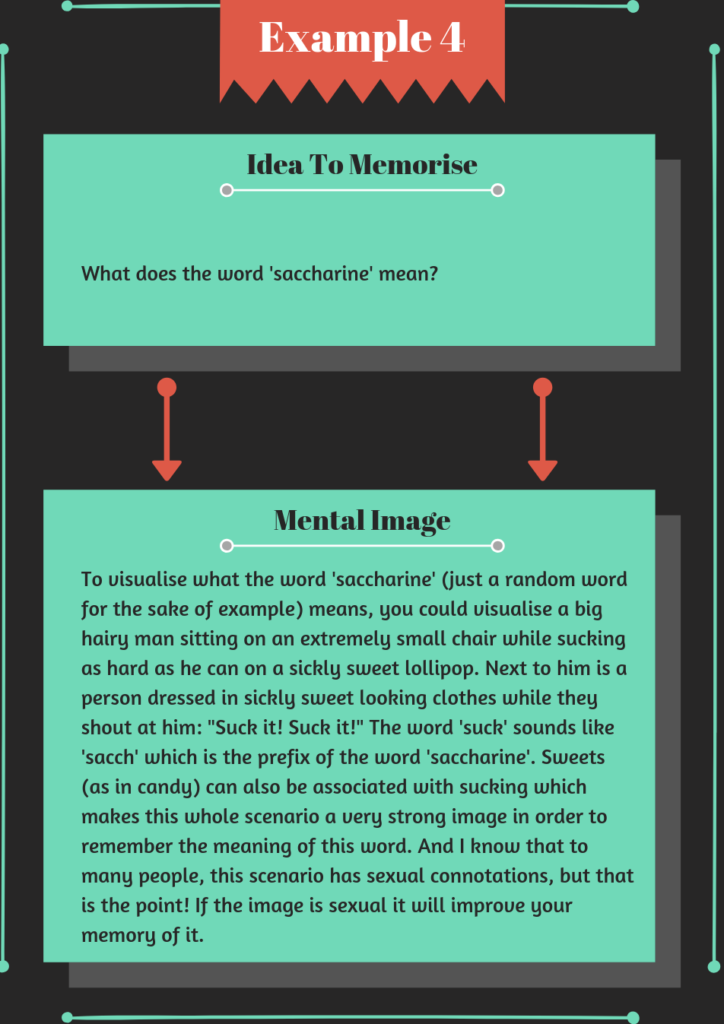
These are all very strong images that enable me to recall details about concepts that I want to keep in my memory.
Also, by just having been through the process of visualising the meaning of the word, you will automatically remember it better. This is because you have done something actively to remember it instead of just assuming that it will stick to your memory by passively observing it.
A mind palace can be used for both short term and long term memory. In my opinion, there are a lot of other techniques for short term memory that can be used, so I would personally save such a structured entity as a mind palace for those powerful long term memories.
Be as Detailed as Possible in Your Visualisation
You have to be very visually clear. Visualise details as well as you can. When you're virtually walking in the halls of your mind palace, it should be as if you are walking there in real life. It's great training for your creative visualisation skills as well.
Chapter 7
MAINTAIN YOUR MIND PALACE!

This is very important. And it's something that you won't learn in a lot of other sources. A lot of other guides quickly explain how you can use a mind palace. Some people might be intrigued and start to use the technique.
But guess what happens next.
After a few weeks, they stop using it because they don't know how to keep it up. Sustaining your memory of your mind palace and carry on using it for a long time can be difficult if you don’t know how to do it.
I don't want you to start using a mind palace and the just forget all about it a few weeks later. I want your mind palace to be a solid tool that you can take advantage of for years.
That’s what we’re going to talk about in this chapter.


